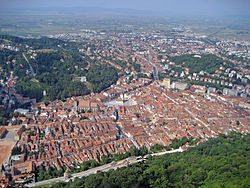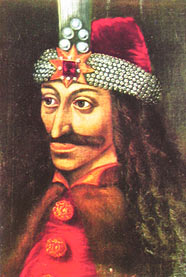 |
| Romanian flag |
The flight time passed rather quickly because I had a TV on the seat in front of me. I saw lots of movies I've never seen & had several free drinks. Short lay-over in London then on to Bucharest. We set our clocks back 6 hours. We had opted for a 3 day pre-cruise tour of Transylvania. Viking put us up in downtown Bucharest at the Radisson Blu, - a 1st class joint. The next day, a herd of us took a bus to Brasov, a wonderful town. "According to the last Romanian census, from 2011, there were 253,200 people living within the city of Brașov, making it the 7th most populous city in Romania, and the metropolitan area is home to 369,896 residents.
Brașov is located in the central part of the country, about 166 km north of Bucharest and 380 km (236 mi) from the Black Sea. It is surrounded by the Southern Carpathian mountains and is part of the Transylvania region.
The city is notable for being the birthplace of the national anthem of Romania and for hosting the Golden Stag International Music Festival.

From 1950 to 1960, during part of the Communist period in Romania, the city was called Orașul Stalin (Stalin City), after the Soviet leader Joseph Stalin".

"Black Church" (Biserica Neagră), which some claim to be the largest Gothic style church in Southeastern Europe.
"Biserica Neagră ("The Black Church"), a celebrated Gothic site - the building dates from 1477, when it replaced an older church (demolished around 1385). Its acquired the name after being blackened by smoke from the 1689 great fire".
Catherine's Gate, the only original city gate to have survived from medieval times
"The city center is marked by the mayor's former office building (Casa Sfatului) and the surrounding square (piaţa), which includes one of the oldest buildings in Brașov, the Hirscher Haus".
Hollywood-type sign on top of Tâmpa Mountain
I found the story of these windows very interesting & we saw them most places we visited. You can see the sign of the cross which was/is to keep evil out.
Pretty girls in the city square
Little bikes for rent in the city square
We left Brasov & visited Peles Castle. "The complex is northwest of the town of Sinaia, which is 60 kilometres (37 mi) from Braşov and 135 kilometres (84 mi) from Bucharest. Nestled in the southeastern Carpathian Mountains. By form and function, Peleş is a palace, but it is consistently called a castle. Its architectural style is a romantically inspired blend Neo-Renaissance and Gothic Revival similar to Schloss Neuschwanstein in Bavaria. A Saxon influence can be observed in the interior courtyard facades, which have allegorical hand-painted murals and ornate fachwerk similar to that seen in northern European alpine architecture. Interior decoration is mostly Baroque influenced, with heavy carved woods and exquisite fabrics". Darn, they wouldn't let us take pictures inside.
They put us up at a Ramada Inn which seemed to be in the middle of nowhere. The staff was overwhelmed by our presence. We were tired & hungry. The little dining room couldn't seat all of us at one time & there was no chatting over the din of voices. We were sitting near the stage - a trio was playing American-type music.
Turns out they play for the Romania Symphony so we begged them to stop playing "American" music & play what they know best. WOW!!! what an unexpected treat. We weren't tired any more & closed the joint.
7/4 Next stop - Transylvania!! Oh...the rumors. We didn't know what to expect.

Secret passage inside the castle, connecting the first and third floors.
from the top of Bran Castle
Beautiful grounds. It was quite a challenge climbing up cobble stones to reach the castle. We sorta had a tour but there was no organization once we reached the inside of the castle. It was chaotic people coming & going the wrong way & tons of loud, squealing & out of control school kids. Transylvania has quite a long & involved history so, if interested, google it. How did the vampire stories get associated with this county?
"The connection of the name "Dracula" with vampirism was made by Bram Stoker, who probably found the name of his Count Dracula character in William Wilkinson's book, An Account of the Principalities of Wallachia and Moldavia: with various Political Observations Relating to Them. It is known that Stoker made notes about this book. It is also suggested that Stoker may have been made aware of the reputation of Vlad through an acquaintance of his, Hungarian professor Ármin Vámbéry from Budapest. The fact that character Dr. Abraham Van Helsing states in the 1897 novel that the source of his knowledge about Count Dracula is his friend Arminius appears to support this hypothesis, although there is no specific evidence that Stoker and Vambéry ever discussed Wallachian history".
Somehow, the story about Vlad the Impaler ((Vlad Tepes), a horrible & gruesome guy, is somehow involved in the stories of Dracula
"Tales of the supernatural had been circulating in Romanian folklore for centuries when Irish writer Bram Stoker picked up the thread and spun it into a golden tale of ghoulishness that has never been out of print since its first publication in 1897. To research his immortal tale, Stoker immersed himself in the history, lore and legends of Transylvania, which he called a “whirlpool for the imagination.Count Dracula, a fictional character in the Dracula novel, was inspired by one of the best-known figures of Romanian history, Vlad Dracula, nicknamed Vlad Tepes (Vlad the Impaler), who was the ruler of Walachia at various times from 1456-1462. Born in 1431 in Sighisoara, he resided all his adult life in Walachia, except for periods of imprisonment at Pest and Visegrad (in Hungary). For more information about Bram Stocker's Dracula Novel please visit www.literature.org/authors/stoker-bram/dracula/” After all that excitement & brains full of information, we were happy to return to Bucharest & the comfortable hotel.
On 7/5 they took us on a city tour of Bucharest - So much history, remnants of communist-built structures &, of course, many churches.
 |
| new building built on top of an old one |
 |
| Painted ceiling in a very old church-downtown Bucharest |
Carlo, the 1st King -
The horse has one leg up means he died from battle wounds; if a statue of a horse has all 4 legs down means the rider died of natural causes; if both legs of the horse are up means the rider died in battle.
Grand Hotel
Palace of Parliment built by the Communists
"Construction began in 1983; the cornerstone was laid on 25 June 1984. While the building was intended to house all four major state institutions (in a similar manner to the UK Houses of Parliament), Ceausescu intended the palace to be his personal residence and the government was to operate in it (as if combining the Kremlin into one building).
At the time of Nicolae Ceauşescu's 1989 overthrow and execution, the building structure and design were complete.] Subsequently, many of the furnishings were never installed (mostly evident because of the many large, empty spaces throughout the palace), while the last three basement levels and a large clock tower (that would display the official Romanian time) were never finished. During the regime change, the new leaders of Romania referred to the building as the House of Ceauşescu, to highlight the excessive luxury in which Ceauşescu would have lived, in stark contrast to the squalor and poverty endured by many people living in Romania at the time.Parts of the building (some of the west wing, some of the east wing, parts of the second floor, basement 3 and everything below) are yet to be completed. Currently, a new underground car-park is being built inside a former stadium, currently used as a warehouse, which was covered during the construction of the palace. Tunnels linking 13 Septembrie Avenue with the basement of the building are planned to be built. It is said] that Ceauşescu had built bunkers under the building where he would hide in case of a revolution".
The 'Alley' between an old hotel
.JPG) |
| I was only pretending - honest - but everyone was smoking these
Wayne was NOT pretending - I didn't see anyone eating this monster ice cream concoction
|
7/6 Was a busy day. We visited many locations including the very interesting National Village museum - This outdoor museum includes more than 300 buildings representing the history of Romania's rural architecture . The structures have been re-located &/or re-created from actual structures from all over Romania.

On to a very nice lunch with lively entertainment. (they really took good care of us)
Next stop, the Romanian Patriarchal Cathedral. Once again, there is so much historical information on this cathedral that I am unable to repeat it here...but very interesting so suggest check it out online.
Romanian women
All passengers were excited to stop touring, get settled in our cabin, have dinner & have a much needed DRINK! We were bused to the port of Giurgiu (pronounced 'jew jew') where we boarded Viking Aegir, our home for the next 23 days.
This is not the boat, but a passage way to the beautiful Aegir
.JPG)
.JPG)
.JPG)
.JPG)



.JPG)
.JPG)
.JPG)
.JPG)

.JPG)



.JPG)
.JPG)





.JPG)
.JPG)

.JPG)
.JPG)

-001.JPG)
.JPG)
.JPG)
.JPG)
.JPG)

No comments:
Post a Comment